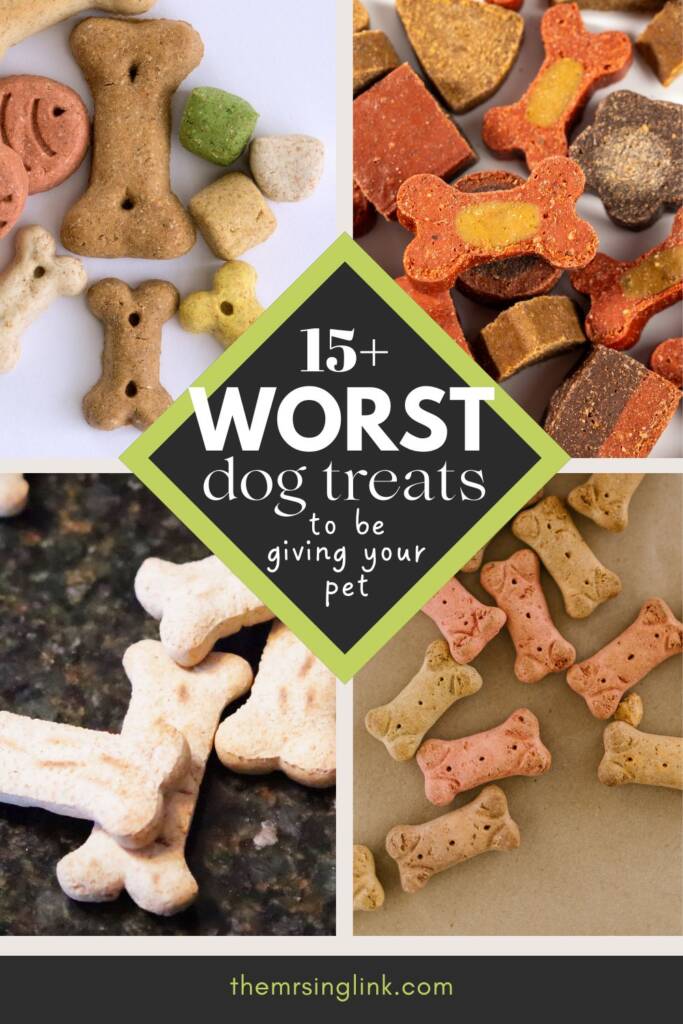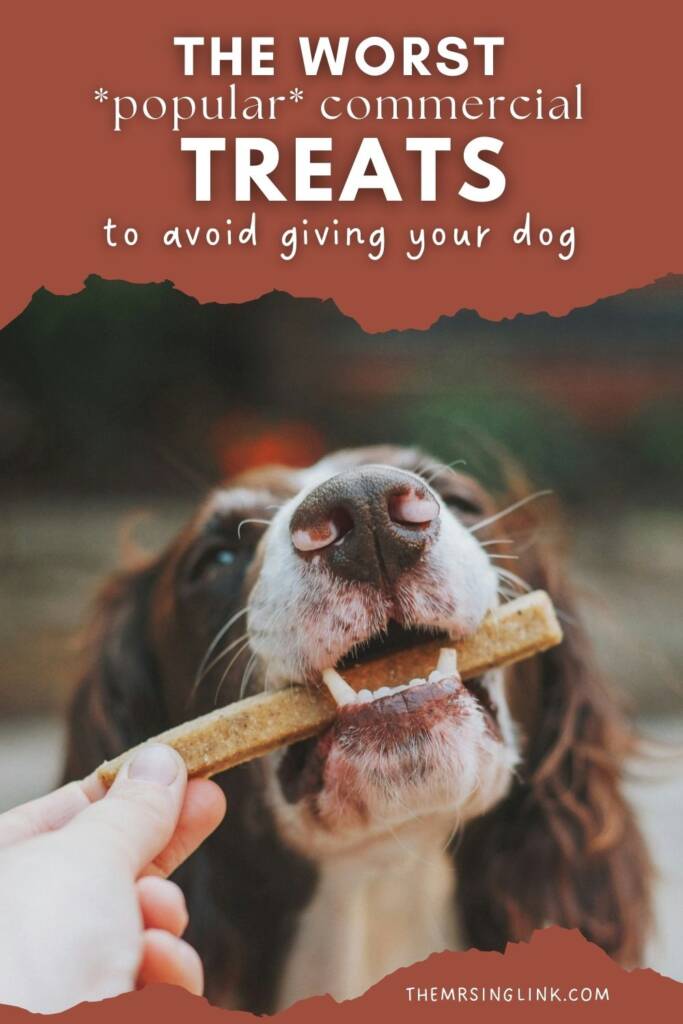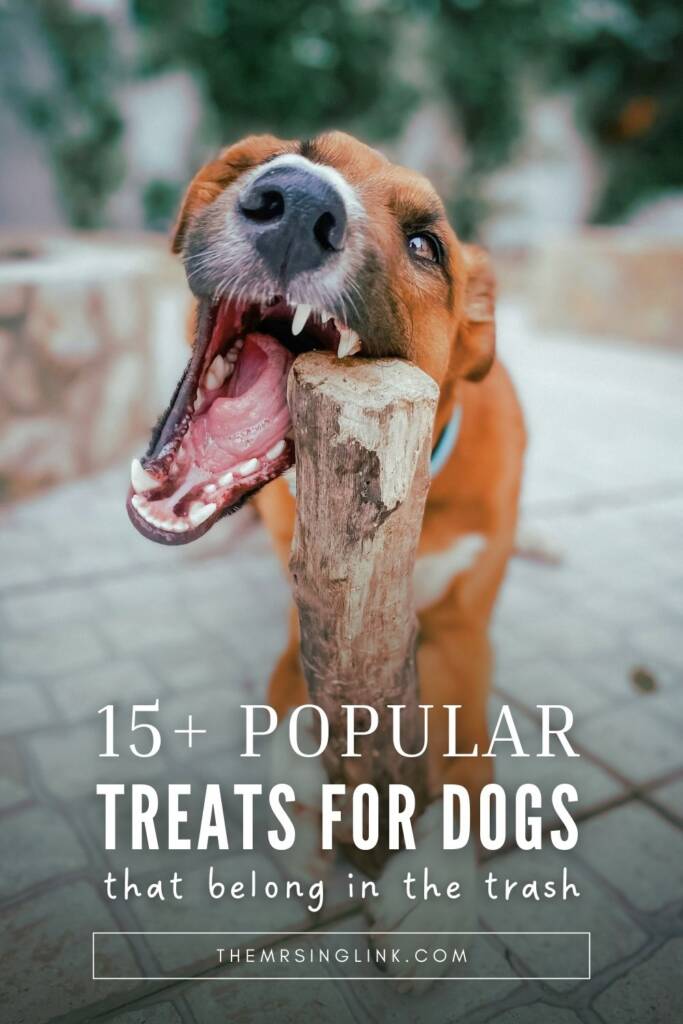Mhm, yessir, yes’m, we’re going there. And I’m not scared, especially if I’m backdoor saving you your hard-earned money as well as your pup’s health, too. These [still] popular dog treats still remain on the shelves (and many, many more like them) and they are absolute garbage.
It’s maddening, because the only reason for these treats to still be on the shelves *today* are because people still buy them!
I say this: what’s popular isn’t always *good*, and what’s good isn’t always *popular*. So when I ventured down this rabbit hole and saw the 4.8 out of 5 star rating out of over 10,000 reviews on some of these treats…I am left disheartened. Mainly for the dog who’s eating them.
This post contains affiliate links. All products and links listed on TML are affiliates through 3rd parties such as Awin, Etsy and Amazon. Meaning, at no cost to you, by clicking and purchasing through those links I will earn a small commission. As an Amazon Associate, I earn from qualifying purchases. To learn more read TML Terms and Disclosure.
Now, I may not be a Vet, or an *expert*, but any Joe-Shmoe can do a quick search to find out that many of the ingredients found in these dog treats are, in fact, garbage. And it’s not like the published studies on the interwebs are denying it.
What frustrates me is the “in moderation” or “correlation is not causation”. If we’re giving our dogs [multiple] treats daily, that’s not considered moderate. It’s same as having a few McDonald’s Big Macs per day, and many commercialized dog treats are just that! And if we’re giving our dogs treats with a carcinogenic ingredient that is “safe” in small amounts, how is it still considered safe if that ingredient is in various sources that are being regularly consumed! Nonetheless, I call BS that health isn’t affected by GRAS ingredients long-term, but that’s just me.
What we will unpack throughout this post..
Many may say these brands and treats have been on the market seemingly forever, and because of that nothing is wrong with them. They’ll claim, “..because why would they put something on the shelves that wasn’t *good*,” and, “..who would dare create something to intentionally *harm* our pets??” I ask the very same question pertaining to certain ingredients that are banned in other countries, like known carcinogens and artificial colors and flavors yet are blissfully making millions and billions on our shelves today in the US.
I apologize for the passion, but I’m not sorry on this one.
This post breaks down what I think are [only] some of the *worst* yet popular commercialized dog treats on the market. First, I organize them by why they’re absolute trash (you’ll see repeat products and brands in each category). Second, I do link to these so you – for yourself – can check the listed ingredients (to prove I am no fool). And third, don’t worry, I offer you better alternatives (with the link to their ingredients as well).
*Again, because I have to say this – no, I am not a professional, and the information throughout this post is strictly opinion (opinion defended by facts, if I’m being honest). So, please, seriously – if you love your pet – do yourself a favor and research for yourself! Oh, and put these treats in the trash where they belong.
15+ Popular Dog treats that belong in the trash

Artificial Colors and Flavors
I’ll say the quiet part out loud. Dogs don’t NEED coloring in their food or treats. It’s actually comical (and maybe even criminal) because it’s we who care – the ones that buy into them – not our pets. So, really, the colors are for us – purely a marketing gimmick, and we fall for it hard. As for added flavors, the fact those things are necessary to make a treat more appealing to eat – for a dog’s already more advanced sense of smell – is nothing short of pathetic.
- Milkbone. Don’t even get me started on their “Pride Flavor Snacks” with all the artificial colors of the rainbow, but see for yourself.
- Purina Beggin’ Strips. “Added color” and “Natural Flavor(s)”, including Smoke Flavor (?? like, why??).
- Canine Carry Outs. Smoke flavor, right behind the slew of colors like Red 40 and Titanium Dioxide.
- Pedigree Dentastix. Natural Poultry Flavor, Yellow 5 and Blue 2.
- Good ‘N’ Fun Rawhide Kabobs. The array of colors like yellow 6, Blue 1 and Red 40, plus beef and pork hide (which is controversially harmful).
- Snausages in a Blanket. Yellow 6, yellow 5, Red 40 as well as titanium dioxide (for color).
Sugar, Sugar, Sugar
Along with high fat, excessive carbohydrates, and salt content, sugar is a major contributor to weight gain and other serious health impacts to our pets. Our pets really don’t need any of that in their diet, especially not within the first few ingredients.
- Soft & Chewy Milkbone. Sugar being the THIRD ingredient.
- Purina Beggin’ Strips. Full of unnecessary carbs and corn as well as having glycerin and sugar on top of it.
- Canine Carry Outs. Sugar, glycerin AND corn syrup all less than TEN ingredients in.
- Hartz Oinkies. Glycerin, Sorbitol AND Maltodextrin, guys???
- Purina Busy with Beggin’. Glycerin and Hydrogenated Corn Syrup – soooo…high-fructose corn syrup.
- SmartBones Peanut Butter. Cornstarch #1, glycerin #2, sorbitol #4, fructose #6, maltrodextrin #7, and barley malt syrup #8 on the ingredients list; not to mention the Red 40, ARTIFICIAL chicken and peanut butter flavor!
“Known” Carcinogens + Harmful Ingredients
Per studies on rats, there are many “known” carcinogens (and reproductive/endocrine disruptors/neurotoxins) to humans in our food. These same carcinogens can be found in food and treats for dogs as well, so where do we get this idea that what’s harmful for humans isn’t somehow harmful to our pets?
- Pupperoni Triple Steak. Well, the ingredients contain ‘bacon’, ‘sausage’ and ‘pepperoni’ – cured meats – which are known carcinogens; along with propylene glycol, BHA and ‘other’ meat-by-product.
- Milkbone. They use BHA and BHT (a hormone disruptor, possibly carcinogenic and harmful to the reproductive system) as a preservative throughout; while *experts* say the harm comes in excess amounts, but these preservatives are found in too many processed foods!
- Maro-Snacks by Milkbone. Contains Sodium Metabisulfite, a preservative, per the FDA should not be used in meat (harmful side effects); also contains BHA and BHT.
- Bil-Jac Training Treats. Contains BHA preservative.
- Ol’Roy Bark’n Bac’n Treats. Contains ‘Bacon’, a cured meat and known carcinogen; not to mention BHA, titanium dioxide and artificial colors.
- Purina Busy Bone. Not only Hydrogenated Corn Syrup (so, high-fructose corn syrup) but also partially hydrogenated oil (trans fat, which is no longer GRAS per the FDA) – big health no-no’s!
- Howl’s Kitchen Bacon Treats. Contains ‘Bacon’, a cured meat and known carcinogen; as well as corn syrup and an array of artificial colors and flavors.
By-products + other “synthetics”
Yes, yes, yes, we’re used to seeing and hearing the sweet undertones for by-product or the word “meal”, and what they mean in pet foods. Let’s underline the fact that by-products presenting itself as the “main” or only protein source in dog food is a bit misleading in terms of meat protein. There isn’t anything *wrong* with bones and organ meat, since that is considered the by-product, but its questionable and worrisome when brands are solely using by-product and meal in place of actual meat.
As far as synthetics goes, I’m not just talking about the vitamins and minerals added to most pet foods these days. There are a slew of other synthetic chemicals used as emulsifiers, thickeners, conditioners, additives, moisture absorption, and the like. Again, the key is consumption in excess is when deemed harmful, but if these synthetics are being used in almost everything, and they’re being consumed daily…I’m not convinced consumption is not excessive and therefore not harmful.
- Soft & Chewy Milkbone. Propylene Glycol is within the first TEN ingredients, a synthetic humectant, so as to keep food *moist*. Known studied side-effects in cats, yet there is no limit to the amount put in dog food/treats (per the AAFCO), so WHY would I willingly want to chance giving that to my dog!?
- Milo’s Kitchen Chicken Meatballs and Beef Sausage Slices. Both containing propylene glycol as the fourth ingredient.
- Maro-Snacks by Milkbone. Slew of by-products including “poultry digest”, as well as sugar and added color.
- Dingo Dental Sticks. Contains Tetrasodium Pyrophosphate, a synthetic additive known for removing rust from metal (high concentrations affecting the kidney in dogs). Um, the pet industry is not regulating how much of these things they’re putting in, and they.don’t.have.to!
- Canine Carry Outs. Glyceryl Monostearate (lots of known, listed side effects when ingested ‘in excess’) – so…who isn’t giving their dogs treats regularly?!
- Pupperoni. Meat-by-product as their #1 ingredient – very wholesome and trustworthy of them to inform you of what meat exactly you’re giving; could be the bits of sickened, dead and disease animals for all we know.
So what can you do?
Limit these things, greatly, if not eliminate them entirely.
Honestly, we’re conditioned to believe that keeping our dogs “happy” or rewarding them comes from food. It doesn’t have to be. Treats are the #1 reason my own furbaby gains weight very easily. We’re not the best at understanding that treats are to be supplemental (in moderation), but we still tend to view that as something to be consumed daily (and that being *okay*)…when not every treat is the same. Some are higher in calories, fat, sugar or salt than others, and depending on your size dog one whole treat daily could be considered beyond the moderated amount.
Anyway, the point I’m making here is that – besides other reasons – I did away with most treats for my dog….and yet I don’t feel it has ANY sort of negative impact on his “emotional” happiness. I reward him in other ways, such as more time outside, more affection and attention, positive affirmation, “toy time” (playing with him with his toys) and simply engaging with him more often (talking to him, responding to his bids for connection, etc.).
This post contains affiliate links. All products and links listed on TML are affiliates through 3rd parties such as Awin, Etsy and Amazon. Meaning, at no cost to you, by clicking and purchasing through those links I will earn a small commission. As an Amazon Associate, I earn from qualifying purchases. To learn more read TML Terms and Disclosure.
What to look for in commercialized treats for dogs
Single ingredient options. Yes, these are generally your dehydrated or freeze-dried raw treats on the market.
Nothing artificial. Get to know for yourself what is and isn’t artificial. “Natural flavors” are technically derived organically but they are still chemical compounds added to food. Make your own determination there.
Grain-free. Personally, I’m back and forth on this because I see nothing particularly wrong with dogs having “grains” (rice, barley, oats, millet, quinoa, etc.) as a smaller part of their diet, but not the majority. BUT, your dog doesn’t really benefit from treats that are basically made with all corn, wheat, and flour. On the other hand, be careful with grain-free in that the ingredients used aren’t just filler replacements (they’re sneaky that way) – i.e., chickpeas, pea protein, potatoes, etc.. In treats, in moderation, these are fine.
No “hide”. Many treats for dogs on the market actually contain hide – like pork or beef. These are typically your small chew bones labeled as treats. You’ll need to do your own research on the dangers of hide and make your own self-determination, but as far as my opinion goes…hide isn’t worth the risk giving to my dog.
Low salt and sugar. There’s already plenty of preservatives used that are salts (like calcium chloride), so the fact that there needs to be extra ‘Salt’ in treats with cured meats, like bacon, is bonkers. Now, I get it, salt amplifies the taste of foods…so, again, it’s really about how much obvious salt is going into these treats to watch out for.
As far as sugar goes, there is absolutely no need to see corn syrup, sugar, brown sugar, molasses, HFCS, fructose, maltrodextrin or cane sugar all on the same ingredients list, especially as one of the first few ingredients (since they go in order from primary to least). Choose options especially without artificial sweeteners and refined sugars first and foremost.
Mixed Tocopherols in place of BHT and BHA. Mixed Tocopherols are a combination of types of Vitamin E used in preservation. These are increasingly more popular and widely used today, so it’s important to steer clear of dog treats that are using synthetics such as BHT and BHA as preservatives.
Progress, not *perfection*. Listen, I DID go through a period where I said no more, no treats…because I found it more difficult to find something without ANY of the bulk listed above (that didn’t cost an arm and a leg). But then I realized that perfection can’t exist unless I’m willing to accept that I won’t find it out there – at the store. And, honestly, this is true. You can choose better options, not perfect, while also limiting how many different kinds of treats you’re giving (at once) and how often you’re giving them.

Better treat alternatives on the market
Aside from the fiasco amount of absolute garbage yet somehow *popular* dog treats on the market, there are certainly a variety of treats for dogs that don’t contain the slew of junk above. These are some of the brands I trust and that I’ll give my dog – be sure to look at the ingredients for yourself:
WHAT I GIVE MY DOG – RIGHT NOW:
- Vital Essentials Beef Liver. Freeze-dried, single ingredient.
- Stella & Chewy’s Chicken Bites. Freeze-dried, single ingredient.
- PLATO Wild Caught Baltic Herring. Air-dried, single ingredient.
- Charlee Bear Chicken Soup & Garden Veggie. *Not grain-free, but fewer, simpler ingredients.
- PLATO Small Bites Air-dried Duck Training Treats. Fewer ingredients, real meat primary protein source.
OTHER BETTER ALTERNATIVES BASED ON INGREDIENTS:
- Pro-Treat Beef Liver Training Treats. Freeze-dried, single ingredient.
- Pur-Luv Chicken Jerky. Minimal, limited ingredients, single protein.
- Northwest Naturals Raw Rewards Freeze-Dried Green Lipped Mussel Treats. Freeze-dried, single ingredient; great source for joint health.
- Wholesome Pride Sweet Potato Chews. Plant-based, single ingredient; good source of fiber.
- Pupford Freeze-dried Training Treats. Limited ingredients, freeze-dried.
- BIXBI Hip + Joint Chicken Jerky. Limited ingredients, single protein source.
- Icelantic+ Freeze-dried Herring. Freeze-dried, single ingredient.
- Smart Cookie Bakery Wild Boar + Sweet Potato. Limited ingredients, single protein source; also has plant-based protein.
- WAG Turkey + Sweet Potato Jerky. Limited ingredients, single meat protein source as primary ingredient, also has plant-based protein.
- *Dave’s Renal Kidney Support, Low Phosphorus, Low-Protein Treat. *Good treat for senior pets with Kidney issues, or dogs who require a low/no protein, low phosphorus diet – not only subjected to dogs with renal issues; limited ingredients, plant-based protein only.
- *Get Naked Grain-free Dental Chews. *Good dental chew alternative for weight-management (since most dental chews are high in calories, especially if you’re giving them frequently); limited ingredients, though not thrilled with the “natural chicken flavor”.
Better treat alternatives from home
Here’s something else: you can give your dog REAL, WHOLE FOODS (that you eat, yourself). You can even make homemade dog treats!
I’m really not sure why the Veterinary industry has put so much fear into pet parents about giving their dogs real food. At the end of the day, commercialized dog food is…made with…real human food. As much as I commend Vets for deterring pet owners from giving their dogs the array of foods that ARE toxic to dogs – like grapes, onions, raisins and chocolate – I often feel their focus is not enough on the fact that real, whole foods are beneficial to our pets.
Their too busy saying “Avocados are toxic – stay away!!!!” when, in fact, avocados themselves are not toxic….it’s their skin and pit dogs cannot have. So do I give my dog a bite of avocado if I’m making guacamole – absolutely, I do. That is, before I have even touched the onion and tomatoes.
Unfortunately, the average person (American, likely) thinks it’s somehow a solid idea – again, *okay* – to give their dog things like pasta (drenched in the sauce), cheese on the reg, mashed potatoes smothered in butter on Thanksgiving, or the heavily seasoned chicken, ribs and steak from the grill…and they wonder why their dog had or has chronic pancreatitis. Basically, human-grade food that is processed and/or consumed with butter, loads of salt, and sugar. All the things dogs don’t need and, yes, shouldn’t have.
Can our brains simply not compute?! That foods such as real blueberries, broccoli, squash, bell peppers (NOT HOT), apples, green beans and the like are all wonderful treat options for our dogs in moderation. Sure, not every dog can stomach certain or every ingredient – my dog gets gassy from cabbage. If I ate cabbage every day for days on end I’d be gassy with likely diarrhea, too. That doesn’t mean I totally nix the idea of giving real whole foods!
The idea is to always, always, always start small and slooooooow. Never give your dog too much of one thing at once.
REAL, FRESH, WHOLE FOODS YOU CAN BE SUPPLEMENTING YOUR DOG *AS TREATS*
- Cucumbers, watermelon (without seeds), cooked squash (butternut, acorn)
- Blueberries, apples, bananas, kiwifruit, strawberries, mango
- Peas, green beans, broccoli, celery
- Okra, cauliflower, cabbage
- Chickpeas, sweet potato, pumpkin
- Leafy greens: bok choy, kale (cooked), spinach (cooked)
And the list goes on. Seriously, do your own research, because the billion dollar pet industry doesn’t always have our pet’s best interest and quality of life in mind.


